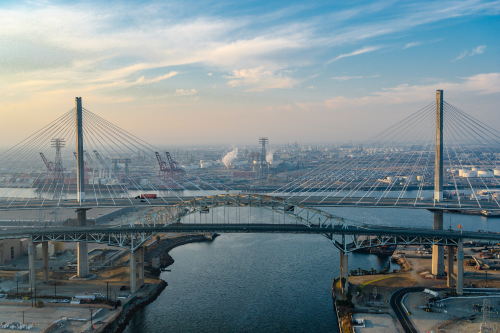The massive new bridge at the Port of Long Beach accomplishes a key goal – improving the flow of international cargo through the country’s largest port complex and improving overall traffic flow along one of Southern California’s key commuter routes.
The six-lane, nearly two-mile-long bridge opened to traffic in October 2020, marking the end of a nearly 10-year, $1.47 billion effort to replace the 52-year-old Gerald Desmond Bridge, which was too narrow and too low to accommodate today’s roadway cargo traffic demands and the larger cargo ships that began arriving at the Port of Long Beach years ago.
On opening day and since, semi-trucks have made good use of the smoother transitions connecting the bridge to the 710 Freeway at its eastern end, and from the similar improvements at the western end of the bridge where it connects to Terminal Island and State Route 47. One feature at the western end of the bridge is a first for California – a “Texas U-turn,” a non-signaled undercrossing that enables continuous travel for trucks and cars. This innovation for the state accelerates goods movement through the area.
Vehicle flow over the bridge benefits from the extra lanes and a lesser grade. The old Gerald Desmond Bridge narrowed from three ascending lanes to two at its apex, causing weaving and merging – and without emergency lanes, an accident or truck breakdown could create significant traffic jams. The new bridge features three lanes in each direction, plus emergency shoulders on both sides. And, although the main span of the new bridge is more than 50 feet higher, the actual grade is about one to two percent less because the starting points at each end are extended farther.
Improving the flow of cargo is part of ongoing efforts by the Port of Long Beach to remain internationally competitive. More than 2.5 million jobs throughout the U.S. are generated by the trade moving through the Port. Each year, the Port handles cargo valued at more than $170 billion. A better bridge – one that could reliably handle vehicle and cargo needs for the next several decades – was essential given that more than 15 percent of the nation’s imported container cargo travels over this route.
Mario Cordero, executive director of the Port of Long Beach, said the new bridge “is much more than a convenient roadway. It is a critical link in the global movement of cargo. It is a bridge to everywhere.”
A taller bridge also will ensure improved passage of cargo ships entering the Port of Long Beach’s inner harbor berths. The Port is already “big ship ready” and has seen some of the world’s largest container ships arrive at its outer harbor berths. The old Gerald Desmond Bridge, completed in the 1960s when cargo ships were about one-sixth the size they are today, will be taken down. Demolition is expected to be completed by 2022.
Another first utilized by bridge contractor SFI was the use of a movable scaffolding system (MSS) to construct the long approaches to the main span. Two custom-designed machines, each weighing about 3.1 million pounds, were raised at opposite ends of the bridge project and attached to the support columns, allowing for a rapid, efficient and safe construction of the roadway. As one 250-foot section of roadway was completed, the self-propelled MSS would travel to the next set of columns to start again the process of laying rebar and placing concrete.
Center span construction was different. After completion of the two signature towers that reach 515 feet into the air, crews lifted pre-assembled steel frames (called pier tables) to attach to the first set of four cables at each tower. Cranes would then extend the road decks in a process that connected 140-foot-wide steel floor beams to edge girders then layered with pre-cast concrete panels that were stitched together to create the road deck.
Seismic features
Additional features
LED lights that change colors light up the cables and two towers, making this bridge a very visible structure at night from many points across Los Angeles and Orange counties.

